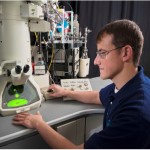 The Michigan Technological University Mobile Lab was a featured exhibitor at the 2014 Battery Show – “The Expo for Advanced Batteries” – and the Electric & Hybrid Vehicle Technology Expo September 16-18 at Novi, Michigan, USA.
The Michigan Technological University Mobile Lab was a featured exhibitor at the 2014 Battery Show – “The Expo for Advanced Batteries” – and the Electric & Hybrid Vehicle Technology Expo September 16-18 at Novi, Michigan, USA.
The lab was set up indoors at the Battery Show in Novi, where Professor Steve Hackney (MSE), instructor Trever Hassell (ECE), Mobile Lab operations manager Chris Davis, and Mobile Lab director Jeremy Worm provided hands-on seminars to conference and show attendees.
